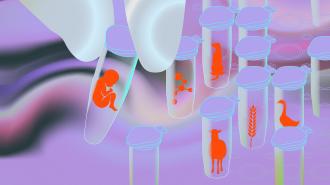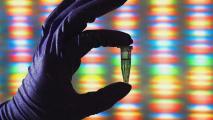Embryos have this beigey color that you would expect to see on an old computer. At least that’s how they look under the microscope. But an embryo is one of the most powerful things on this planet. A single cell that can turn into any living animal from a giraffe to a human. It’s hard not to have awe when looking at one. And gene editing one? That’s something else entirely.
It’s every scientist’s dream to gene edit embryos. If they say otherwise they’re just naive or fooling themselves. The first time I did it, it was a bit surreal, one of those things that makes your whole body a little tingly. Using a joystick for precision control of the micro-injection needle as I stabbed the membrane, it made me wonder if the future will really turn out like an 80s sci-fi movie. A pedal click caused a silent whoosh as the embryo’s contents swirled, churned by the invisible force of the air pressure that injected the gene edits into the core. I felt like a BioPunk Priestess hacking the sacred genome.
I’m not saying it loses its luster, but the other day I accidentally squished an embryo and it popped. I know, embryos are tiny, so how do you squish one? Actually, it was bound to happen after working with thousands. The sacred became mundane. But then what’s not mundane to a god?
We’ve cured diseases. Built rocket ships 400-feet-tall that can launch off our planet. We made sand think! No other animal has come close to achieving our level of societal and technological sophistication. If animals could talk, we would be their gods. In fact, we are their gods. And we’re hardly benevolent. We’ve bred animals bigger just to eat them, made tiny jitter goblins as pets, and wiped out some to extinction.
So why does gene editing freak people out? A human-supplied enzyme catalyzes a precision reaction separating a DNA base from the phosphate backbone, thereby changing genes, and suddenly people want to press the pause button. Nature takes millions of years to fumble toward something useful when an amateur could now do it in a day with just a click and a whoosh. Hesitation isn’t morality. It’s fear.
Do we really plan to wait for evolution to catch up with us? To sit on the hands that we should be using to sculpt life? Life itself is now our medium, our raw material. This is the moment where we decide that living things should no longer be crippled by generations of genetic missteps and evolutionary local minima.
Genetic engineering, the ability to modify an organism’s DNA, has been around for about 50 years. In the 1970s, scientists began recombining genetic material in bacteria, taking DNA from different organisms and splicing it together. By 1974, animals were being genetically modified, livestock followed a decade later, and in 1989, Oliver Smithies, Mario Capecchi, and Martin Evans created the first targeted gene edit in animals using homologous recombination. It sounds fancy, but it’s really not. After decades of progress, the primary use of this technology was creating mice with cancer so that scientists could study them.
Then came gene targeting technologies, like CRISPR, over 10 years ago. With these technologies we can delete, modify, add, or change any gene in any organism’s DNA and it’s easy and cheap. Are you thinking what I’m thinking? Where are my Pokémon?
The scientific industrial complex is fundamentally broken. Scientists are trapped in a system of their own creation that values paywalled publications over real progress. If they can’t even make knowledge freely available, how can they be expected to push the boundaries of innovation? A field built on gatekeeping will never lead the future.
The real question isn’t whether we can do this. The real question is what comes next. The first steps are already happening in the lab of my new company, the Los Angeles Project (LAP). We are learning to harvest large amounts of embryos and eggs from different animal species so we can understand the development of life on a scale no one has tried before. We are editing genes and injecting DNA with micro-precision, sculpting biology at its most fundamental level.
We started small with amphibians and fish before progressing to small mammals like mice and hamsters. Now we are working with rabbits and soon we’ll be working with cats and dogs and agricultural animals.
We are not just altering what already exists. We are laying the groundwork for entirely new creatures, shaping their biology with intent instead of relying on nature’s roll of the dice, as has been done before.
The idea of mythical animals has always been just that, an idea. But there is no scientific reason why a unicorn or a dragon cannot exist. The only barrier is the work it takes to make them real. And we are doing the work. As we learn more, scale and progress we will create new branches in the tree of life, the first new kingdom in almost a billion years.
Nature is only sacred because we are uncertain about the power we wield over it. But now, for the first time in the history of life on Earth, we can purposefully change genetics. It’s our moral obligation to seize this opportunity and build better life.






